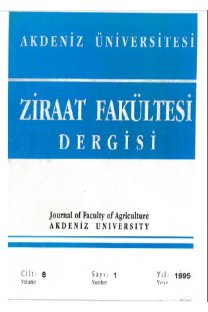Doğal Lupinus varius (L.) populasyonunda gün uzunluğunun tohum bağlama tohum ve bazı çimlenme özelliklerine etkisi
Bu çalışmada gün uzunluğunun doğal Lupinus varius L. populasyonunda tohum bağlama, tohum ve elde edilen tohumların çimlenme özelliklerine etkisi araştırılmıştır. 26 Eylül tarihinde ısıtmasız plastik sera koşullarına ekim yapılmış, ekimden 30 gün sonra başlamak üzere doğal, 14 ve 16 saat gün uzunluğu uygulanmıştır. 14 ve 16 saat gün uzunlukları doğal gün uzunluğunun geceyi bölme (GBA) aydınlatması (400-7000nm dalga boyundal,8-l,9 $\mumol-s^{-1}m^{-2}$) ile 14 ve 16 saate tamamlanması şeklinde uygulanmış ve aydınlatmalar 30 Nisan tarihinde bitirilmiştir. Fotoperiyodik aydınlatmalar çiçeklenmeye kadar geçen süreyi kısaltmış, doğal ve 16 saat gün uzunluğu etkisinde daha yüksek sayıda çiçek elde edilmiştir. Birincil çiçek salkımlarında doğal ve 14 saat gün uzunluğu, ikincil çiçek salkımlarında ise 16 saat ve doğal gün uzunluğu daha yüksek bakla ve tohum sayısı ile bakla oluşturma ve tohum bağlama oranlarının elde edilmesini sağlamıştır. En yüksek tohum verimleri (g/bitki) doğal ve 16 saat, en yüksek tohum ağırlıkları (g/tohum) ise 16 ve 14 saat gün uzunluğu uygulamalarında saptanmıştır. Sonuçlar gün uzunluğunun çiçeklerime süresi ve çiçek sayısı, sıcaklıkların ise döllenme ve tohum bağlama üzerinde daha etkin olduğuna ilişkin ipuçları vermiştir. 12 günlük çimlenme testleri sonucunda gün uzunluklannın etkisinin oluşan fidelerin yalnızca sürgün boyu ve kuru ağırlığına yansıdığı ve 16 ve 14 saat gün uzunluğu etkisinde elde edilen tohumlanıl fidelerinde bu değerlerin daha yüksek olduğu belirlenmiştir.
Anahtar Kelimeler:
yetiştirme yöntemleri, tohum tutma, tohum kalitesi, tohum çimlenmesi, Lupinus varius, süs bitkileri, çiçeklenme zamanı
Influence of photoperiod onseeding seed and subsquent germination characteristics in native population of lupinus varius L.
The effects of photopenod on seeding, seed and subsequent gennination characteristics in a native population of Lupinus varius L. were investigated. The seeds were sown in an unheated plastic greenhouse on 26 September. Natural, 14 and 16-h photopenod treatments were started 30 days after sowing and continued until 30 April. 14-h and 16-h photoperiods were provided by extending the natural day lengths to 14 and 16 hours by the use of night break lighting (1.8-1.9 $\mumol-s^{-1}m^{-2}$ in 400-700 nm). Photoperiodic lighting shortened the time from sowing to flowering and higher flower numbers were counted under natural and 16-h photoperiods. Higher values of pod and seed numbers and percentages of podding and seeding were obtained under natural and 14-h photoperiods for main inflorescences and under natural and 16-h photoperiods for branch inflorescences. The peak seed yields (g/plant) and seed weights (g/seed) were recorded under natural and 16-h photoperiods and under 14 and 16-h photoperiods, respectively. These results pointed out that photoperiod is more effective on flowering time and flower numbers, whereas temperature is more effective on seeding and seed characteristics. At the end of 12-days testing period, effects of photoperiod on daughter seed germination characteristics were only observed in shoot lengths and dry weights. Higher shoot length and dry weight values were recorded in 12-days old seedling raised from seeds, which were collected from plants grown under 14 and 16-h photoperiods.
Keywords:
cultural methods, seed set, seed quality, seed germination, Lupinus varius, ornamental plants, flowering date,
___
- Alvarado, A.D., Bradford, K.J. and Hewitt, J.D., 1987. Osmotic priming of tomato seeds. Effects on germination, field emergence, seedling growth and fruit yield. Journal of American Society of Horticultural Science, 112: 427-432.
- Cevri, H. ve Başçetinçelik, A., 2000. Akdeniz Bölgesindeki Değişik Örtü Malzemeli Seralarda Işınım Geçirgenlikleri ile Güneş Işınımı ve Fotosentez İçin Etkin Işınımın (PAR) Belirlenmesi Üzerinde Bir Araştırma. Derim 17(4):154-170.
- Christiansen, J.L. and Jornsgard, B., 2002. Influence of daylength and temperature on number of main stem leaves and time to flowering in lupin. Ann. Of App. Bio. , 140(1):29-35.
- Clapham, W.M., Willcott, J.B. and Fedders, J.M., 2000. Effects of seed maturation temperature on seed yield characteristics and subsequent generation of lupin. Crop Sci. 40:1313-1317.
- Couvillon, G.A., 2002. Cercis canadensis L. seed size influence germination rate, seedling dry mater and seedling leaf area. HortScience, 37(1):206-207.
- Dracup, M., Thomson, B., Reader, M., Kirby, E.J.M.,Shield, I. and Leach, L., 1998. Daylength responses, flowering time, and seed flling in lupins. Austr. Jr. of Agric. Research, 49(7):1047-1055.
- Duke, J. A., 1981. Handbook of Legumes of World Economic Importance. Plenum Press, New York, 345 pp.
- Karagüzel, O., Akkaya, F., Türkay, C., Gürsan, K.,Özçelik, A. Erken, K. ve Çelikel, F. G., 2001a. Süs Bitkileri Alt Komisyonu-Kesme Çiçekler Raporu. Sekizinci Beş Yıllık Kalkınma Planı- Bitkisel Üretim (Süs Bitkileri) Özel İhtisas Komisyonu Raporu DPT Yayın No. DPT:2645- ÖİK:653, Ankara,s.1-60.
- Karagüzel, O., Baktır, I., Çakmakçı, S., Ortaçeşme, V.,Aydınoğlu, B. ve Atik, M., 2001b. Gün Uzunluğu Ekim Tarihleri ve Paclobutrazolun Gazipaşa Yöresi Doğal Acıbaklalarının (Lupinus varius L.) Büyüme ve Çiçeklenmelerine Etkileri Üzerinde Araştırmalar. (Sonuç Raporu) TÜBİTAK Proje No. TARP –1814, 65 s.
- Keeve, R., Kruger, G.H.J., Loubser, H.L., Mey,J.A.M. van der and van der Mey, J.A.M., 1999. Effect of temperature and photoperiod on the development of Lupinus albus L. in a controlled environment. Jr. of Agr. And Crop Sci., 183(4):217-223.
- Keeve, R., Loupser, H.L. and Kruger, G.H.J., 2000. Effects of temperature and photoperiod on days to flowering, yield and yield compenent of Lupinus albus (L.) under field conditions. Jr. of Agro. and Crop Sci., 184(3):187-196.
- Reeves, T.G., Boundy, K.A. and Brooke, H.D., 1977. Phenological development studies with Lupinus angustifolius and L. albus in Victoria. Aust. Jr. of Expr. Agric. and Ani. Husb. 17(87):637-644.
- Ruan, S., Xue, Q. and Tylkowska, K., 2002. The influence of priming on germination of rice(Oryzo sativa L.) seeds and seedling emergence and performance in flooded soil. Seed Science & Technology, 30:61-67.
- Tomaszewski, Z., Idzkowska, M. and Koczowska, I.,1978. The effect of seed size of the sowing material on the fresh matter. Biuletyn Instytutu Aklimatyzacji Roslin No. 132:3-15.
- ISSN: 1301-2215
- Yayın Aralığı: Yılda 2 Sayı
- Başlangıç: 1983
- Yayıncı: Akdeniz Üniv. Ziraat Fak.
Sayıdaki Diğer Makaleler
M. Kubilay ÖNAL, BÜLENT TOPCUOĞLU, Asri Nuri ARI
BÜLENT TOPCUOĞLU, M. Kubilay ÖNAL, Asri Nuri ARI
HALİL DEMİR, Muharrem GÖLÜKCÜ, AYHAN TOPUZ, FERAMUZ ÖZDEMİR, ERSİN POLAT, HİLAL ŞAHİN NADEEM
